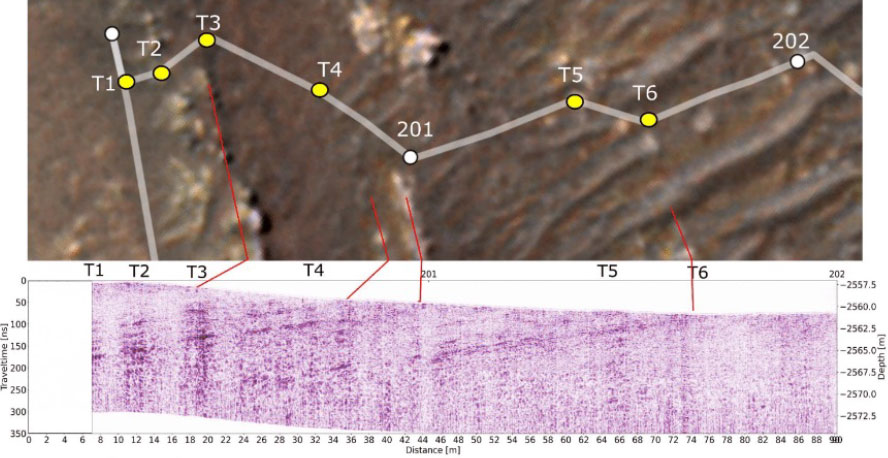Perseverance’s Traverse, Seen From Above and Below

| Credit | NASA/JPL-Caltech/University of Arizona/USGS/FFI |
|---|---|
| Language |
|
This annotated-composite graphic shows the entry of NASA’s Perseverance rover into the “South Séítah” geologic unit from both an orbital and subsurface perspective.
The annotated view from NASA’s Mars Reconnaissance Orbitor (MRO) depicts the route Perseverance took into Séítah. The image was provided by MRO’s High Resolution Imaging Experiment (HiRISE).
The graphic below the orbital image is the first “radargram” to be released by the Radar Imager for Mars' Subsurface Experiment (RIMFAX) instrument aboard Perseverance. It shows the subsurface as the rover drove across the “Artuby” ridgeline. The red lines link bright subsurface “reflectors” to erosion-resistant layers outcropping at the surface.
The University of Arizona, in Tucson, operates HiRISE, which was built by Ball Aerospace & Technologies Corp., in Boulder, Colorado. NASA's Jet Propulsion Laboratory, a division of Caltech in Pasadena, California, manages the Mars Reconnaissance Orbiter Project for NASA's Science Mission Directorate, Washington.
A key objective for Perseverance's mission on Mars is astrobiology, including the search for signs of ancient microbial life. The rover will characterize the planet's geology and past climate, pave the way for human exploration of the Red Planet, and be the first mission to collect and cache Martian rock and regolith.
The Mars 2020 Perseverance mission is part of NASA's Moon to Mars exploration approach, which includes Artemis missions to the Moon that will help prepare for human exploration of the Red Planet.
Subsequent NASA missions, in cooperation with ESA (European Space Agency), would send spacecraft to Mars to collect these sealed samples from the surface and return them to Earth for in-depth analysis.
NASA's Jet Propulsion Laboratory in Southern California built and manages operations of the Mars 2020 Perseverance rover for NASA.
For more information about the mission, go to:
